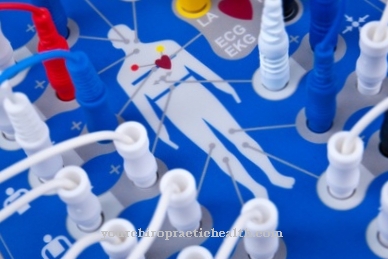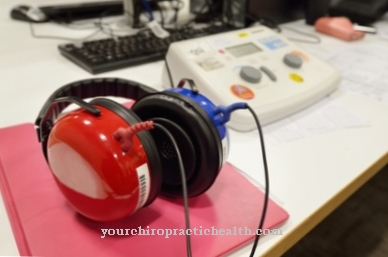The Phlebology is a medical branch that deals with venous disorders such as varicose veins, thrombosis or phlebitis. To make a diagnosis, phlebology uses standard procedures such as Doppler sonography or duplex sonography. Compression therapy and stripping are among the most important phlebological treatment measures.
What is phlebology

Phlebologists are engaged in the prevention, examination, treatment and rehabilitation of venous diseases. The most famous of these are varicose veins. In Germany, phlebology is not an independent specialty. Instead, the title of phlebologist can be acquired through further training after the actual specialist training.
Both trained general practitioners and dermatologists, specialists in internal medicine or surgeons can become phlebologists. The main prerequisite for participating in the training is at least two years of clinical practical experience. The advanced training usually lasts 1.5 years and takes place in an institution authorized to provide training.
In addition to dealing with phlebological devices, the training also includes the treatment of various venous diseases. Angiology must be distinguished from phlebology. In addition to venous diseases, this branch of internal medicine also deals with lymphatic diseases and arterial diseases.
Treatments & therapies
In addition to varicose veins, the specialty of phlebology includes spider veins, phlebitis, thrombosis and chronic venous insufficiency. In the latter, the outflow from the leg vein is disturbed. The lower legs and feet swell or lie open. This so-called ulcus cruris is understood as a complication of venous insufficiency and causes oozing wounds in the late stage.
The venous insufficiency is often the result of a previous thrombosis. An untreated venous disease can trigger such a leg vein thrombosis. In addition to venous insufficiency, venous thrombosis can also have life-threatening consequences. Leg vein thrombosis is usually the result of slowed blood flow or vascular damage. A clot of blood forms. If this clot breaks loose, a pulmonary embolism, often fatal, can result.
In phlebology, compression therapy is often used to prevent venous clots. This physical compression is a conservative therapy. It forms the basic therapy for almost all venous disorders and even accompanies surgical interventions. Both compression bandages and compression stockings are part of compression therapy. They speed up and maintain the flow of blood in the veins.
In addition to this conservative therapy method, phlebologists also use drug therapies for some venous diseases. For example, sclerotherapy can be carried out for varicose veins. A 27 percent saline solution is applied intravascularly. A deliberate sclerus or thrombus forms and closes the vascular structures.
On the other hand, an unwanted thrombus can also be resolved in a controlled manner by drug therapies. This is the goal of thrombolysis, where a drug to dissolve the thrombus is given intravascularly. Important drugs for phlebology are pain reliever analgesics, anti-inflammatory anti-inflammatory drugs, anticoagulant anticoagulants and venotonic drugs that strengthen veins. In addition to conservative and medicinal therapy measures, phlebology also includes surgical treatment measures.
The most important include phlebotomy, perforant ligation and stripping. In microsurgical phlebotomy, varicose veins are removed piece by piece through small punctures. With perforant ligation, the connections between the depths and the surfaces of a vein are prevented. This is usually done as part of a stripping process, which pulls long and straight varicose veins out of the body in one piece with the help of a steel wire. In the meantime, phlebology also uses thermal methods for the treatment of venous disorders, especially vein-draining laser methods.
Diagnosis & examination methods
The most important examination and diagnostic procedures in phlebology are Doppler sonography, duplex sonography, photophlethysmography, phlebodynamometry and vein occlusive plethysmography. In Doppler sonography, the phlebologist examines the superficial venous valves by making an ultrasound image of the vessels.
In this way, he can determine the speed of blood flow in the veins. Doppler sonography is the standard diagnostic tool for all vascular diseases. During the examination, the doctor can also identify varices, for example. These are superficial veins with pathological enlargement that suggest a thrombus. The diagnostic instrument of photophlethysmography, on the other hand, measures the blood filling of the lower leg. This measurement takes place externally. The lower leg does not have to be opened for this imaging procedure.
The result of this photophlethysmography helps the doctor to assess the extent of the damage and the consequences for the entire venous system. Phlebodynamometry, which measures the venous pressure during exercise, must be distinguished from photophlethysmography. The patient runs or does squats while the pressure is being measured. The doctor measures the pressure on the dorsal vein with a pressure transducer and can thus assess the functionality of the venous valves. The effects of varices can also be guessed at. In order to determine the vein functions more closely, the phlebologist, on the other hand, uses a vein occlusive plethysmography.
A blood pressure cuff is placed around the patient's thigh. There are silicone rings with a resistance fluid on his lower leg. The venous blood cannot leave the leg vein in this way. The pent-up blood is drained again by loosening the cuffs. The faster it drains, the less likely it is to block the vein. Color-coded duplex sonography has become a final, standard diagnostic method for phlebology.
This method of ultrasound examination shows the vein walls exactly and without stress for the patient. Vein calcifications and phlebitis can be diagnosed in the early phase using this examination method. A good phlebologist can also use visual diagnosis to identify some venous disorders, such as leg ulcers or other serious complications.

























.jpg)

.jpg)
